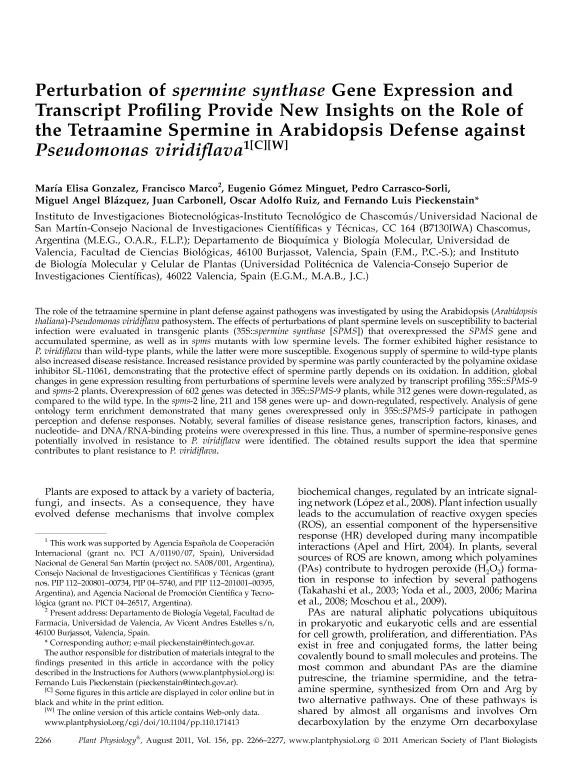Mostrar el registro sencillo del ítem
dc.contributor.author
Gonzalez, Maria Elisa

dc.contributor.author
Marco, Francisco
dc.contributor.author
Minguet, Eugenio Gómez
dc.contributor.author
Carrasco-Sorli, Pedro
dc.contributor.author
Blázquez, Miguel Angel
dc.contributor.author
Carbonell, Juan
dc.contributor.author
Ruiz, Oscar Adolfo

dc.contributor.author
Pieckenstain, Fernando Luis

dc.date.available
2020-01-20T19:45:40Z
dc.date.issued
2011-08
dc.identifier.citation
Gonzalez, Maria Elisa; Marco, Francisco; Minguet, Eugenio Gómez; Carrasco-Sorli, Pedro; Blázquez, Miguel Angel; et al.; Perturbation of spermine synthase gene expression and transcript profiling provide new insights on the role of the tetraamine spermine in Arabidopsis defense against pseudomonas viridiflava; American Society of Plant Biologist; Plant Physiology; 156; 4; 8-2011; 2266-2277
dc.identifier.issn
0032-0889
dc.identifier.uri
http://hdl.handle.net/11336/95280
dc.description.abstract
The role of the tetraamine spermine in plant defense against pathogens was investigated by using the Arabidopsis (Arabidopsis thaliana)-Pseudomonas viridiflava pathosystem. The effects of perturbations of plant spermine levels on susceptibility to bacterial infection were evaluated in transgenic plants (35S::spermine synthase [SPMS]) that overexpressed the SPMS gene and accumulated spermine, as well as in spms mutants with low spermine levels. The former exhibited higher resistance to P. viridiflava than wild-type plants, while the latter were more susceptible. Exogenous supply of spermine to wild-type plants also increased disease resistance. Increased resistance provided by spermine was partly counteracted by the polyamine oxidase inhibitor SL-11061, demonstrating that the protective effect of spermine partly depends on its oxidation. In addition, global changes in gene expression resulting from perturbations of spermine levels were analyzed by transcript profiling 35S::SPMS-9 and spms-2 plants. Overexpression of 602 genes was detected in 35S::SPMS-9 plants, while 312 genes were down-regulated, as compared to the wild type. In the spms-2 line, 211 and 158 genes were up- and down-regulated, respectively. Analysis of gene ontology term enrichment demonstrated that many genes overexpressed only in 35S::SPMS-9 participate in pathogen perception and defense responses. Notably, several families of disease resistance genes, transcription factors, kinases, and nucleotide- and DNA/RNA-binding proteins were overexpressed in this line. Thus, a number of spermine-responsive genes potentially involved in resistance to P. viridiflava were identified. The obtained results support the idea that spermine contributes to plant resistance to P. viridiflava.
dc.format
application/pdf
dc.language.iso
eng
dc.publisher
American Society of Plant Biologist

dc.rights
info:eu-repo/semantics/openAccess
dc.rights.uri
https://creativecommons.org/licenses/by-nc-sa/2.5/ar/
dc.subject
SPERMINE
dc.subject
BIOTIC STRESS
dc.subject
PSEUDOMONAS VIRIDIFLAVA
dc.subject
ARABIDOPSIS THALIANA
dc.subject.classification
Bioquímica y Biología Molecular

dc.subject.classification
Ciencias Biológicas

dc.subject.classification
CIENCIAS NATURALES Y EXACTAS

dc.title
Perturbation of spermine synthase gene expression and transcript profiling provide new insights on the role of the tetraamine spermine in Arabidopsis defense against pseudomonas viridiflava
dc.type
info:eu-repo/semantics/article
dc.type
info:ar-repo/semantics/artículo
dc.type
info:eu-repo/semantics/publishedVersion
dc.date.updated
2020-01-15T20:03:02Z
dc.journal.volume
156
dc.journal.number
4
dc.journal.pagination
2266-2277
dc.journal.pais
Estados Unidos

dc.journal.ciudad
Rockville
dc.description.fil
Fil: Gonzalez, Maria Elisa. Consejo Nacional de Investigaciones Científicas y Técnicas. Centro Científico Tecnológico Conicet - La Plata. Instituto de Investigaciones Biotecnológicas. Universidad Nacional de San Martín. Instituto de Investigaciones Biotecnológicas; Argentina
dc.description.fil
Fil: Marco, Francisco. Universidad de Valencia; España
dc.description.fil
Fil: Minguet, Eugenio Gómez. Consejo Superior de Investigaciones Científicas; España
dc.description.fil
Fil: Carrasco-Sorli, Pedro. Universidad de Valencia; España
dc.description.fil
Fil: Blázquez, Miguel Angel. Consejo Superior de Investigaciones Científicas; España
dc.description.fil
Fil: Carbonell, Juan. Consejo Superior de Investigaciones Científicas; España
dc.description.fil
Fil: Ruiz, Oscar Adolfo. Consejo Nacional de Investigaciones Científicas y Técnicas. Centro Científico Tecnológico Conicet - La Plata. Instituto de Investigaciones Biotecnológicas. Universidad Nacional de San Martín. Instituto de Investigaciones Biotecnológicas; Argentina
dc.description.fil
Fil: Pieckenstain, Fernando Luis. Consejo Nacional de Investigaciones Científicas y Técnicas. Centro Científico Tecnológico Conicet - La Plata. Instituto de Investigaciones Biotecnológicas. Universidad Nacional de San Martín. Instituto de Investigaciones Biotecnológicas; Argentina
dc.journal.title
Plant Physiology

dc.relation.alternativeid
info:eu-repo/semantics/altIdentifier/url/http://www.plantphysiol.org/content/early/2011/05/31/pp.110.171413.abstract?sid=e33cc1e1-a7ee-45d0-a5d2-0cec3762f1b4#aff-1
dc.relation.alternativeid
info:eu-repo/semantics/altIdentifier/doi/http://dx.doi.org/10.1104/pp.110.171413
Archivos asociados
